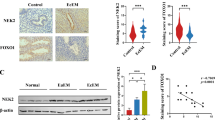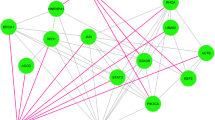Abstract
Purpose
To evaluate whether miR-148a-3p overexpression is associated with disrupted decidualization of recurrent implantation failure (RIF).
Methods
Endometrial miRNA and mRNA expression profiles during the implantation window derived from women with and without RIF were identified using microarray and RT-qPCR. Immortalized human endometrial stromal cells (HESCs) were cultured for proliferation and in vitro decidualization assays after enhancing miR-148a-3p expression or inhibiting putative target gene homeobox C8 (HOXC8) expression. RT-qPCR, western blot, and luciferase reporter assays were used to confirm the relationship between miR-148a-3p and HOXC8 gene.
Results
MiR-148a-3p was significantly upregulated in RIF endometrial tissues. Forced expression of miR-148a-3p notably attenuated HESC in vitro decidualization. Mechanistic studies revealed that miR-148a-3p directly bounds to the HOXC8 3′ untranslated region (3′UTR) and suppressed HOXC8 expressions in both mRNA and protein levels. Further investigations demonstrated that inhibition of HOXC8 in HESCs induced similar effects on decidual process as those induced by miR-148a-3p overexpression.
Conclusion
Taken together, our findings suggested that elevated miR-148a-3p might account for flawed decidualization in RIF by negatively regulating HOXC8, raising the possibility that miR-148a-3p might be a novel therapeutic target in RIF.




Similar content being viewed by others
References
Thornhill AR, deDie-Smulders CE, Geraedts JP, Harper JC, Harton GL, Lavery SA, et al. ESHRE PGD Consortium Best practice guidelines for clinical preimplantation genetic diagnosis (PGD) and preimplantation genetic screening (PGS). Hum Reprod. 2005;20(1):35–48.
Valdes CT, Schutt A, Simon C. Implantation failure of endometrial origin: it is not pathology, but our failure to synchronize the developing embryo with a receptive endometrium. Fertil Steril. 2017;108(1):15–8.
Sebastian-Leon P, Garrido N, Remohí J, Pellicer A, Diaz-Gimeno P. Asynchronous and pathological windows of implantation: two causes of recurrent implantation failure. Hum Reprod. 2018;33(4):626–35.
Gellersen B, Brosens JJ. Cyclic decidualization of the human endometrium in reproductive health and failure. Endocr Rev. 2014;35(6):851–905.
Ochoa-Bernal MA, Fazleabas AT. Physiologic events of embryo implantation and decidualization in human and non-human primates. Int J Mol Sci. 2020;21(6).
Kliman HJ, Frankfurter D. Clinical approach to recurrent implantation failure: evidence-based evaluation of the endometrium. Fertil Steril. 2019;111(4):618–28.
Zhu H, Hou CC, Luo LF, Hu YJ, Yang WX. Endometrial stromal cells and decidualized stromal cells: origins, transformation and functions. Gene. 2014;551(1):1–14.
Berkhout RP, Lambalk CB, Repping S, Hamer G, Mastenbroek S. Premature expression of the decidualization marker prolactin is associated with repeated implantation failure. Gynecol Endocrinol. 2020;36(4):360–4.
Brar AK, Frank GR, Kessler CA, Cedars MI, Handwerger S. Progesterone-dependent decidualization of the human endometrium is mediated by cAMP. Endocrine. 1997;6(3):301–7.
Gellersen B, Brosens J. Cyclic AMP and progesterone receptor cross-talk in human endometrium: a decidualizing affair. J Endocrinol. 2003;178(3):357–72.
Ruan YC, Chen H, Chan HC. Ion channels in the endometrium: regulation of endometrial receptivity and embryo implantation. Hum Reprod Update. 2014;20(4):517–29.
Macklon N. Recurrent implantation failure is a pathology with a specific transcriptomic signature. Fertil Steril. 2017;108(1):9–14.
Cha J, Sun X, Dey SK. Mechanisms of implantation: strategies for successful pregnancy. Nat Med. 2012;18(12):1754–67.
Maruyama T, Yoshimura Y. Molecular and cellular mechanisms for differentiation and regeneration of the uterine endometrium. Endocr J. 2008;55(5):795–810.
Vinketova K, Mourdjeva M, Oreshkova T. Human decidual stromal cells as a component of the implantation niche and a modulator of maternal immunity. J Pregnancy. 2016;2016:8689436.
Salilew-Wondim D, Gebremedhn S, Hoelker M, Tholen E, Hailay T, Tesfaye D. The role of microRNAs in mammalian fertility: from gametogenesis to embryo implantation. Int J Mol Sci. 2020;21(2):E585.
Bartel DP. MicroRNAs: genomics, biogenesis, mechanism, and function. Cell. 2004;116(2):281–97.
Engels BM, Hutvagner G. Principles and effects of microRNA-mediated post-transcriptional gene regulation. Oncogene. 2006;25(46):6163–9.
Chen X, Xie D, Zhao Q, You Z-H. MicroRNAs and complex diseases: from experimental results to computational models. Brief Bioinform. 2019;20(2):515–39.
Esteller M. Non-coding RNAs in human disease. Nat Rev Genet. 2011;12(12):861–74.
Seki N, Hata A. Noncoding RNAs: a new fine-tuner is a key player of human pathogenesis. J Hum Genet. 2017;62(1):1.
Bagga S, Bracht J, Hunter S, Massirer K, Holtz J, Eachus R, et al. Regulation by let-7 and lin-4 miRNAs results in target mRNA degradation. Cell. 2005;122(4):553–63.
Reinhart BJ, Slack FJ, Basson M, Pasquinelli AE, Bettinger JC, Rougvie AE, et al. The 21-nucleotide let-7 RNA regulates developmental timing in Caenorhabditis elegans. Nature. 2000;403(6772):901–6.
Estella C, Herrer I, Moreno-Moya JM, Quinonero A, Martinez S, Pellicer A, et al. miRNA signature and Dicer requirement during human endometrial stromal decidualization in vitro. PloS one. 2012;7(7):e41080.
Kuokkanen S, Chen B, Ojalvo L, Benard L, Santoro N, Pollard JW. Genomic profiling of microRNAs and messenger RNAs reveals hormonal regulation in microRNA expression in human endometrium. Biol Reprod. 2010;82(4):791–801.
Sha AG, Liu JL, Jiang XM, Ren JZ, Ma CH, Lei W, et al. Genome-wide identification of micro-ribonucleic acids associated with human endometrial receptivity in natural and stimulated cycles by deep sequencing. Fertility and sterility. 2011;96(1):150–5.e5.
Zhang Q, Zhang H, Jiang Y, Xue B, Diao Z, Ding L, et al. MicroRNA-181a is involved in the regulation of human endometrial stromal cell decidualization by inhibiting Kruppel-like factor 12. Reproductive biology and endocrinology : RB&E. 2015;13:23.
Chill HH, Dior UP, Kogan L, Revel A. microRNAs and endometrial pathophysiology. Adv Exp Med Biol. 2015;887:143–55.
Galliano D, Pellicer A. MicroRNA and implantation. Fertil Steril. 2014;101(6):1531–44.
Revel A, Achache H, Stevens J, Smith Y, Reich R. MicroRNAs are associated with human embryo implantation defects. Hum Reprod. 2011;26(10):2830–40.
Zhang Q, Li G, Zhang L, Sun X, Zhang D, Lu J, et al. Maternal common variant rs2305957 spanning PLK4 is associated with blastocyst formation and early recurrent miscarriage. Fertility and Sterility. 2017;107(4):1034–40.e5.
Niklaus AL, Aubuchon M, Zapantis G, Li P, Qian H, Isaac B, et al. Assessment of the proliferative status of epithelial cell types in the endometrium of young and menopausal transition women. Hum Reprod. 2007;22(6):1778–88.
Noyes RW, Hertig AT, Rock J. Reprint of: Dating the endometrial biopsy. Fertility and Sterility. 2019;112(4 Suppl1):e93–e115.
Li S, Zhu J, Zhang W, Chen Y, Zhang K, Popescu LM, et al. Signature microRNA expression profile of essential hypertension and its novel link to human cytomegalovirus infection. Circulation. 2011;124(2):175–84.
Cao C, Sun J, Zhang D, Guo X, Xie L, Li X, et al. The long intergenic noncoding RNA UFC1, a target of MicroRNA 34a, interacts with the mRNA stabilizing protein HuR to increase levels of β-catenin in HCC cells. Gastroenterology. 2015;148(2):415–26.e18.
Chen Y, Song YX, Wang ZN. The microRNA-148/152 family: multi-faceted players. Mol Cancer. 2013;12:43.
Li Y, Deng X, Zeng X, Peng X. The role of Mir-148a in cancer. J Cancer. 2016;7(10):1233–41.
Wang X, Liang Z, Xu X, Li J, Zhu Y, Meng S, et al. miR-148a-3p represses proliferation and EMT by establishing regulatory circuits between ERBB3/AKT2/c-myc and DNMT1 in bladder cancer. Cell Death & Disease. 2016;7(12):e2503.
Cakmak H, Taylor HS. Implantation failure: molecular mechanisms and clinical treatment. Hum Reprod Update. 2011;17(2):242–53.
Taylor HS. The role of HOX genes in human implantation. Hum Reprod Update. 2000;6(1):75–9.
Schmittgen TD, Livak KJ. Analyzing real-time PCR data by the comparative C(T) method. Nat Protoc. 2008;3(6):1101–8.
Choi Y, Kim HR, Lim EJ, Park M, Yoon JA, Kim YS, et al. Integrative analyses of uterine transcriptome and microRNAome reveal compromised LIF-STAT3 signaling and progesterone response in the endometrium of patients with recurrent/repeated implantation failure (RIF). PLoS One. 2016;11(6):e0157696.
Kang YJ, Lees M, Matthews LC, Kimber SJ, Forbes K, Aplin JD. MiR-145 suppresses embryo-epithelial juxtacrine communication at implantation by modulating maternal IGF1R. J Cell Sci. 2015;128(4):804–14.
Shah N, Sukumar S. The Hox genes and their roles in oncogenesis. Nat Rev Cancer. 2010;10(5):361–71.
Lei H, Wang H, Juan AH, Ruddle FH. The identification of Hoxc8 target genes. Proc Natl Acad Sci U S A. 2005;102(7):2420–4.
Shah M, Cardenas R, Wang B, Persson J, Mongan NP, Grabowska A, et al. HOXC8 regulates self-renewal, differentiation and transformation of breast cancer stem cells. Mol Cancer. 2017;16(1):38.
Liu H, Zhang M, Xu S, Zhang J, Zou J, Yang C, et al. HOXC8 promotes proliferation and migration through transcriptional up-regulation of TGFbeta1 in non-small cell lung cancer. Oncogenesis. 2018;7(2):1.
Coutifaris C, Myers ER, Guzick DS, Diamond MP, Carson SA, Legro RS, et al. Reprint of: Histological dating of timed endometrial biopsy tissue is not related to fertility status. Fertility and Sterility. 2019;112(4 Suppl1):e116–e24.
Acknowledgments
We thank Prof. Haibin Wang and colleagues at Xiamen University, Xiamen, China, for constructive insight and valuable advice. The authors expressed gratitude to all participants involved in this study.
Funding
The work was supported by National Key Research & Development Program of China (2016YFC1000202, 2018YFC1002804), Major Program of National Natural Science Foundation of China (81490743), General Program of National Natural Science Foundation of China (81671522, 81571406), Shandong Provincial Key Research and Development Program (2016GGH4522), and the Special Fund of Taishan Scholars Program of Shandong Province.
Author information
Authors and Affiliations
Contributions
All authors contributed to the study conception and design. Junhao Yan designed the study and finally approved the version to be submitted; Qian Zhang and Tianxiang Ni performed the study, analyzed the data, and wrote the paper; Yujie Dang performed the study; Lingling Ding and Jingjing Jiang collected samples and analyzed the data; Jing Li, Mingdi Xia, and Na Yu analyzed the data; and Jinlong Ma and Zi-Jiang Chen revised the paper. All authors read and approved the final manuscript.
Corresponding author
Ethics declarations
The study was approved by the Institutional Review Board of Center for Reproductive Medicine, Shandong University. Informed consent was obtained from all individual participants included in the study.
Conflict of interest
The authors declare that they have no conflict of interest.
Additional information
Publisher’s note
Springer Nature remains neutral with regard to jurisdictional claims in published maps and institutional affiliations.
Electronic supplementary material
Supplemental Table 1.
Primers for RT-qPCR (DOCX 16 kb)
Supplemental Fig 1.
Lentivirus-mediated miR-148a-3p overexpression or HOXC8 inhibition in HESCs (PNG 230 kb)
Rights and permissions
About this article
Cite this article
Zhang, Q., Ni, T., Dang, Y. et al. MiR-148a-3p may contribute to flawed decidualization in recurrent implantation failure by modulating HOXC8. J Assist Reprod Genet 37, 2535–2544 (2020). https://doi.org/10.1007/s10815-020-01900-9
Received:
Accepted:
Published:
Issue Date:
DOI: https://doi.org/10.1007/s10815-020-01900-9




